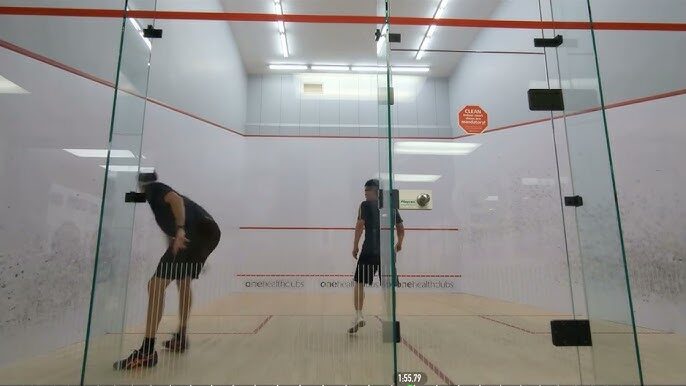Squash is an intense sport that demands quick reflexes, explosive power, and stamina. Whether you’re playing a casual game or in a competitive match, recovery is essential to improve performance and avoid injuries. In this post, we’ll focus on two of the most important recovery techniques for squash players: nutrition and rest.
Why Recovery Matters in Squash
Squash is a high-intensity, fast-paced sport that challenges your muscles, endurance, and cardiovascular system. The repeated sprints, quick directional changes, and constant exertion can leave players feeling fatigued and worn out. Proper recovery is key to ensuring that your body repairs itself and is ready for the next match.
Effective recovery techniques can help reduce muscle soreness, prevent overtraining, and improve overall performance. In this article, we’ll dive into the two most important aspects of recovery: nutrition and rest.
Key Squash Recovery Techniques
While there are numerous ways to recover after a squash game, nutrition and rest are the most foundational components. These two aspects will ensure your body is fueled properly and gets the downtime needed for muscle repair.
Nutrition for Squash Recovery
Importance of Post-Game Nutrition
After a squash match, your body needs to restore its energy levels and repair muscle tissue. The right nutrition can replenish glycogen stores, promote muscle recovery, and keep your immune system strong. If you neglect post-match nutrition, your recovery will be delayed, and you may feel the effects of fatigue and soreness for longer periods.
Key Nutrients for Recovery
To ensure your recovery is as effective as possible, you’ll need to prioritize the following key nutrients:
Carbohydrates: After high-intensity exercise like squash, your body uses up its glycogen stores. Consuming carbohydrates after a game helps replenish this energy and helps prevent fatigue.
Protein: Squash is a physically demanding sport that stresses your muscles. Protein plays a crucial role in muscle repair, and consuming it post-match helps to reduce muscle damage and support recovery.
Fats: Healthy fats are vital for overall recovery. Omega-3 fatty acids, found in foods like fish, nuts, and seeds, are particularly beneficial for reducing inflammation in the muscles and joints.
Micronutrients: Vitamins and minerals support your recovery in various ways. Magnesium helps with muscle function, vitamin C boosts your immune system, and potassium aids in fluid balance.
Ideal Post-Match Meal or Snack
It’s important to eat a balanced meal or snack within 30 minutes to 2 hours after your game. An ideal post-squash recovery meal would be a combination of protein, carbs, and healthy fats. Here are some examples of great options:
- Grilled chicken with quinoa and vegetables
- A protein smoothie with banana, berries, and almond butter
- Greek yogurt with honey and granola
Hydration Tips
Staying hydrated is crucial for recovery. Dehydration can slow down the recovery process and increase the risk of injury. After a squash match, it’s important to replenish both water and electrolytes, which are lost through sweat during the game.
Sports drinks with electrolytes or coconut water are great options. However, for general hydration, always prioritize water throughout the day.
Rest and Sleep for Optimal Recovery
Why Rest is Crucial for Squash Players
While nutrition fuels your body for recovery, rest gives it the time it needs to repair and rebuild. Overtraining without sufficient rest can lead to burnout, injuries, and decreased performance. Rest is where your body heals—muscles repair themselves, and energy stores are replenished.
The Role of Sleep in Recovery
Quality sleep is a critical part of the recovery process. During sleep, your body produces growth hormones that aid in muscle repair and recovery. Aim for 7 to 9 hours of uninterrupted sleep per night for optimal recovery. Sleep also helps regulate your mood, reduce stress, and maintain focus—crucial elements for your squash performance.
Active vs. Passive Rest
Active rest involves light movements or activities that promote blood circulation without placing strain on your muscles, such as walking, light stretching, or yoga. Passive rest, on the other hand, means complete downtime where you do minimal physical activity. Both types of rest are important, depending on your recovery needs.
For most players, a combination of active rest (on non-training days) and passive rest (like sleep or complete days off) works best.
Practical Tips for Implementing Recovery Techniques
To make the most of your recovery, here are some actionable tips to incorporate nutrition and rest into your routine:
- Schedule Rest Days: Plan active and passive rest days into your weekly training schedule.
- Prioritize Sleep: Stick to a consistent sleep routine to maximize the benefits of deep sleep.
- Eat Balanced Meals: Plan meals that balance carbs, proteins, and healthy fats to fuel recovery.
- Hydrate Regularly: Don’t wait until you feel thirsty—drink water consistently throughout the day.
Common Mistakes to Avoid in Squash Recovery
When it comes to recovery, many players make a few common mistakes. Here’s what you should avoid:
- Skipping Post-Match Meals: Don’t skip the post-match nutrition window—your body needs nutrients soon after exercise.
- Not Prioritizing Sleep: Sleep is where most of the recovery happens. Don’t sacrifice rest for extra training or late nights.
- Inadequate Hydration: Ensure you’re hydrating before, during, and after your matches to support recovery.
Proper recovery is just as important as the training you do on the court. By focusing on nutrition and rest, you give your body the tools it needs to recover faster, reduce injury risk, and perform at its best in future matches.
Adopt these squash recovery techniques, and you’ll notice an improvement not just in your recovery time but in your overall performance. Ready to take your squash game to the next level? Start focusing on your recovery today!




